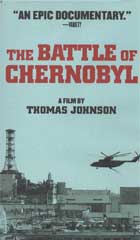
Battle of Chernobyl 2007
Distributed by First Run/Icarus Films, 32 Court St., 21st Floor, Brooklyn, NY 11201; 800-876-1710
Produced by Hind Saih
Directed by Thomas Johnson
DVD, color, 92 min.
College - Adult
Environmental Studies, European Studies, History
Date Entered: 12/12/2007
Reviewed by Michael J. Coffta, Business Librarian, Bloomsburg University of PennsylvaniaThis is simply a mind boggling piece of work. Those of us among the general populace who think that they are at least familiar with the nuclear disaster at Chernobyl in April 1986 need to view this film for a true awakening to the extent of the catastrophe, the inept reaction, and continuing threat posed by the radioactive material still residing at the facility.
Battle of Chernobyl begins with a time and date stamped dramatization of the events stemming from a planned test on self fueling system, leading to an explosion within the power plant’s reactor. My only criticism of the film is that there is no detailed explanation (no diagram or animations) of what precisely caused the explosions. In fairness to the filmmakers, this was most likely done to swiftly move the audience to the accident and its outcomes.
Reaction to the explosion was uncoordinated and communication was slow. The residents of the nearby city of Pripyat were not informed of the overnight disaster and were not evacuated until two days later. The documentary does an excellent job of detailing the Soviets’ response which attempted to put out the fire that was sending massive amounts of radioactive vapor into the air, and to prevent a secondary explosion, equaling ten Hiroshima bombs and would have made half of Europe uninhabitable. One of many deeply disturbing dimensions of this exposition is the Soviets’ duplicitous distortion and withholding of information, even after Western investigators were given access to the area.
The aftermath of the accident saw an equally disturbing chain of events. Workers were not provided with adequate protective gear when removing contaminated material. The levels of radioactivity were so high that the electronics of robotic moving machines broke down. As but one example of sad absurdity, Soviet workers took 45 second shifts in which to shovel radioactive debris off the roof of the buildings. Newly declassified documents have lead to estimates of approximately 20,000 deaths and 200,000 illnesses due to the accident.
Perhaps unknown to many, Chernobyl still houses molten radioactive material which could again contaminate the environment. A “sarcophagus,” or metal housing, was built around the reactor to check the radioactivity. Over the years, however, this sarcophagus has deteriorated and needs approximately $1 billion in renovation.
This is simply a peerless documentary. It was painstakingly researched and offers extensive interviews with former residents of Pripyat, clean-up workers (or “liquidators”), Mikhail Gorbachev, and other major figures in the catastrophe. The film also cleverly situates the events in a political setting, but does not deviate from its focus on the disaster. Most strikingly, the film emphasizes that this “battle” continues today, among the survivors and those who seek to safeguard Europe from the reactor’s ongoing threat. Lastly, viewers will be staggered to learn just how close the world came to witnessing a second, cataclysmic explosion.
This documentary has earned the highest recommendation for its clarity, its persistent revelations, and comprehensive examination of this dismal crisis.
Awards
- Best History & Biography Program, 2007 Banff World Television Awards
- Best Documentary, 2006 Prix Italia Festival